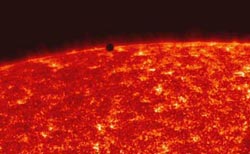
Sun-Earth Day 2007 presents: Living in the Atmosphere of the Sun
The passage of a planet across the sun's fiery disk is a sight worth seeing!
ISSUE #51: THE TRANSIT OF MERCURY
The very idea that a planet could pass in front of the sun is not a new one. Arabic astronomers frequently reported seeing spots on the sun, as did Chinese astronomers. These were not considered to be native to the Sun, but were frequently cited in the Arabic science literature as transits of either Mercury or Venus. In one instance, a transit was expected but not seen, leading the 12th Century Moroccan astronomer Alpetragius to conclude that Mercury emitted its own light. In 807 AD, at the time of Charlemagne, "..the star Mercury was seen in the Sun like a small black spot, a little above the center of that very body, and it was seen by us for 8 days" ( Annales Loiselianos) but it was clearly a sunspot due to its visible size. In 1607, Kepler thought he had seen a predicted transit of Mercury by projecting the Sun's image on a screen through a pinhole, but had instead only detected a sunspot.
The problem is that, even under ideal conditions, the disk of Mercury would be only 10 to12 seconds of arc in diameter, which is 10 times smaller than the finest detail discernable by the human eye under the best of conditions. Actual confirmed sightings had to await the invention of the telescope after ca 1605.
The first confirmed transit of Mercury occurred on November 7, 1631 and was sighted telescopically by the French astronomer Pierre Gassendi (1592-1655). This transit had been predicted by Johannes Kepler (1571-1630), however, Kepler never lived to see this vindication of his precise Rudolphine Tables based on his new theory of planetary motion.
Transits were of interest for more that their cosmic rarity. Pioneering work by Jeremiah Horrocks (1619-1641) during the transit of Venus in 1639, and James Gregory in 1663 at least showed in principle that planetary transits could be used to determine the Earth-Sun distance. This would be a major astronomical accomplishment!
At the time of Copernicus, the Sun-Earth distance was thought to be no more than 10 million kilometers - a number which hadn't changed much since the time of the ancient Greek astronomer Aristarchus of Samos. Even by the time of Kepler, this distance was not thought to exceed 20 million kilometers.
Meanwhile, Sir Edmund Halley had traveled to the island of Sainte-Hélène in the South Atlantic in 1676 to create an atlas of southern stars. While there, he observed the transit of Mercury in 1677, but bad weather made the sightings virtually impossible. In 1716, Halley published "A new Method of determining the Parallax of the Sun, or his Distance from the Earth" by using many observational stations spread over the world. This technique was later used during the transits of Venus in the 18th and 19th centuries to establish a very accurate distance to the sun from earth.
Although there are typically 13 to 14 transits of Mercury each century, the disk of Mercury is so miniscule that sighting it even telescopically is a severe challenge. To make the Sun-Earth distance measurements, an astronomer has to determine the start and end times of the transit to a fraction of a second. With a disk as small as Mercury's, and a turbulent view through the eyepiece, these observations are nearly impossible even when astronomers knew how to use the data afterwards. Only the transits of Venus held out any hope of overcoming the severe observational difficulties with atmospheric distortion, bad optics and crude timepieces, and eventually achieved an accurate 'textbook' measurement of 93 million miles (150 million kilometers).
A movie of the May 7, 2003 transit as seen with the MDI instrument on SOHO.
The latest Flash player plug-in is required to view this movie.
The next five transits of Mercury will occur on
- May 9, 2016
- November 11, 2019
- November 13, 2032
- November 7, 2039
- May 7, 2049
How old will you be during each of these events? Why not write a letter to yourself, to be opened during the next transit in 2016!
REFERENCES
- Odenwald, S.F. and B. DePonteau, 2004 "Calculating the Astronomical Unit from TRACE Observations of the 2003 Transit of Mercury: A classroom activity"
- Fred Espenak's 2006 Transit of mercury page
- SOHO 2003 Transit of Mercury page
- TRACE 2003 Transit of Mercury page
- Sun Earth Day 2004 Transit of Venus page
Technology Through Time
2007 ISSUES
- #57: The Heliosphere
- #56: Coronal Mass Ejections
- #55: Solar Corona, Holes and Wind
- #54: Solar Flares... Oh my!
- #53: Solar Prominences
- #52: Sunspots from A to B - solar magnetism
- #51: The Transit of Mercury
- #50: Ancient Sunlight
- #49: Solar Energy
- #48: The Sun: From Cradle to Grave
View past issues
Authors and Designers
Space Weather Fact
During a single second, the sun converts 4 million tons of matter into pure energy.



